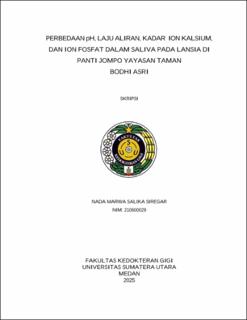Perbedaan pH, Laju Aliran, Kadar Ion Kalsium, dan Ion Fosfat dalam Saliva pada Lansia di Panti Jompo Yayasan Taman Bodhi Asri
Differences in pH, Flow Rate, Calcium lon, and Phosphate lon Levels in Saliva of Elderly Residents at Taman Bodhi Asri Nursing Home

Date
2025Author
Siregar, Nada Marwa Salika
Advisor(s)
Primasari, Ameta
Metadata
Show full item recordAbstract
Aging causes physiological changes and a decline in salivary gland function, which can affect the pH, flow rate, and levels of calcium and phosphate ions in saliva. Aim: to analyze the differences in pH, flow rate, calcium ion levels, and phosphate ion levels in saliva between young adults and the elderly. Methods: this study employed a descriptive-analytic design with a cross-sectional approach, involving 40 participants (20 young adults and 20 elderly individuals). Young adults were aged 18-30 years, while elderly individuals were aged 60-80 years. Saliva was collected using the spitting method, followed by measurement of pH and flow rate, as well as determination of calcium and phosphate ion levels using a spectrophotometer. Data analysis was conducted using the Shapiro-Wilk test, Mann-Whitney test, and Pearson correlation. Results: the average pH and saliva flow rate were higher in young adults than in the elderly, with significant differences observed (p<0.05). Calcium ion levels were found to be higher in the elderly compared to young adults, but the difference was not statistically significant (p>0.05). Phosphate ion levels were lower in the elderly than in young adults, but the difference was also not significant (p>0.05). The relationship between pH and saliva flow rate with calcium and phosphate ion levels in the elderly was found to be non-significant. Conclusion: age affects saliva pH and flow rate but does not significantly influence calcium and phosphate ion levels.
Collections
- Undergraduate Theses [1908]
